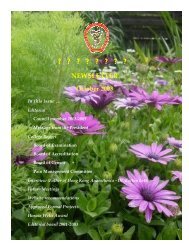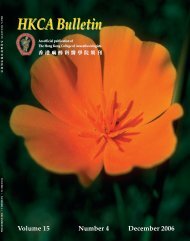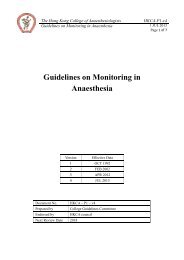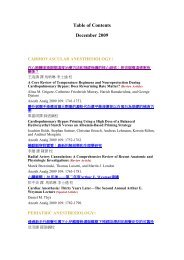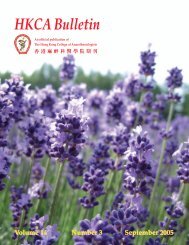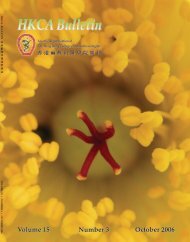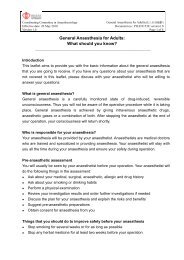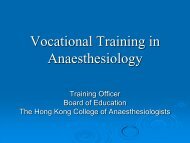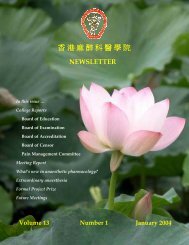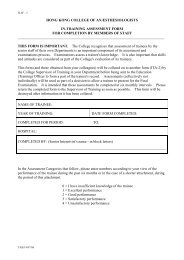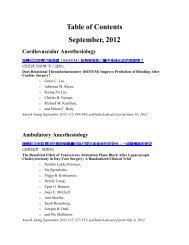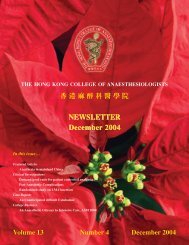July 2005 - The Hong Kong College of Anaesthesiologists
July 2005 - The Hong Kong College of Anaesthesiologists
July 2005 - The Hong Kong College of Anaesthesiologists
Create successful ePaper yourself
Turn your PDF publications into a flip-book with our unique Google optimized e-Paper software.
Bull HK Coll Anaesthesiol Volume 14, Number 2 <strong>July</strong>, <strong>2005</strong>EditorialsBull HK Coll Anaesthesiol <strong>2005</strong>;14:63Why Publish in the Bull HK Coll Anaesthesiol?<strong>The</strong>re are a number <strong>of</strong> reasons that youhave to publish in the Bull HK CollAnaesthesiol. As an <strong>of</strong>ficial publication <strong>of</strong>the <strong>Hong</strong> <strong>Kong</strong> <strong>College</strong> <strong>of</strong> <strong>Anaesthesiologists</strong>,the Bulletin is distributed to over 600 individualsworking locally and aboard. We have an activeplan to extend our distribution beyond thememberships to other institutions and libraries.Articles published in the Bulletin are more likelyto be read by fellows and members than anyother journals published overseas. Eventually,your work will improve our way in practicinganesthesia, intensive care and pain medicine.<strong>The</strong> Bull HK Coll Anaesthesiol is accredited bythe <strong>College</strong> CME Sub‐committee. Normally, thefirst six authors <strong>of</strong> any scientific articlespublished in Bulletin will receive credits pointsunder the category <strong>of</strong> “Publications”. <strong>The</strong> firstauthor <strong>of</strong> each paper is credited with ten pointswhile the remaining authors are credited withfive points.We welcome manuscripts from differentaspects <strong>of</strong> our specialty. Currently, we publishFeatured Articles that describe the practice inour neighborhood. Clinical and LaboratoryInvestigations are designed to publishimportant observations, audits or results <strong>of</strong>clinical trials and experiments. We also welcomeReviews and Case Reports for experiencesharing. <strong>The</strong>re is also Letters to the Editor for usto exchange ideas and to discuss paperspublished in the Bulletin. Manuscripts submittedto Bulletin are reviewed by our “friendly”editorial board and published promptly. <strong>The</strong>Bulletin is also published online in the <strong>College</strong>website.I hope you will agree with me that apublication in the Bulletin worth a lot more thanany other journals!Dr Matthew ChanEditor‐in‐ChiefBull HK Coll Anaesthesiol <strong>2005</strong>;14:63‐6Forced Air Warming using Hospital Blankets: Best for Less?Unintentional perioperative hypothermia(body temperature < 36 o C) occurs inapproximately 50% <strong>of</strong> all surgicalpatients. 1‐3 <strong>The</strong> contributing factors includeimpaired thermoregulation from various forms<strong>of</strong> anesthesia, cold operating room environment,intravenous fluids, antiseptic solutions for skinpreparation and open body cavities. 4Inadvertent perioperative hypothermiapredisposes to many adverse effects on patientrecovery. It is associated with cardiacmorbidities, 5 excessive surgical blood loss, 6increased incidence <strong>of</strong> surgical wound infectionsand prolonged hospital stay. 7 It also contributedto reduced metabolism and clearance <strong>of</strong>numerous drugs. 8,9 More importantly, shiveringas a consequence from hypothermia is mostuncomfortable for the patient. 10Forced air warming is an effective and noninvasiveactive warming system. <strong>The</strong> electrically63



